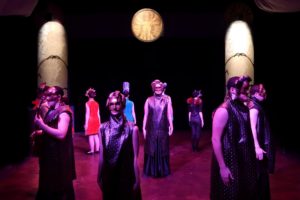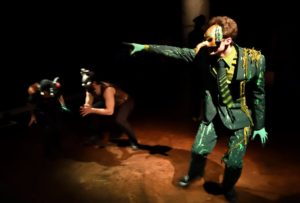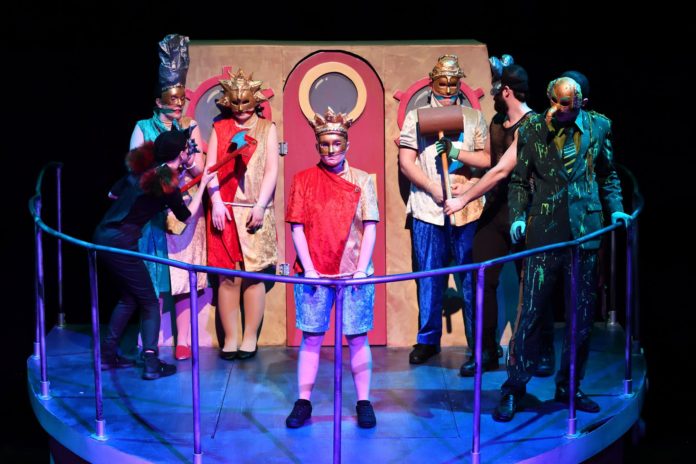What if someone gave you the chance to be a part of The Simpsons? There’s just one catch: you have to survive the apocalypse. Mr. Burns: A Post-Electric Play, by Anne Washburn, is Transylvania’s Theater Department’s latest undertaking, and it’s all about the post-apocalyptic Simpsons.
This production is unlike any other we’ve had, and this became clear before the play even began. As the theater doors opened, the ushers invited the audience to sit on the stage floor where there were orange and brown maple leaves scattered everywhere and a fake campfire in the center with miscellaneous seating around it. Director Drew Davidson explained this unique choice in the program with two reasons. First, he explained that it’s a reflection of a “more primitive version of Theater” when people gathered around fires and told one another stories. His other reasoning was “to immerse [the audience] in the world and get [them] as close to the action as possible.” The audience was given a choice whether they wanted to sit in actual seats or gather on the floor. Most students seemed to choose the floor, with most of the adults and community members choosing the actual seating.
This unusual seating arrangement lasted throughout the first act, entitled “The Very Near Future.” For those on the floor, the performance and actors were so close that it created a feeling of intimacy and actual involvement in the play. Unfortunately, it could be somewhat uncomfortable and a lot of audience members could be spotted constantly shifting around as the act went on.

The seating was not the only interesting part of the pre-show, however. While some audience members were seated and more were being ushered in, several of the characters stepped out onto the stage and began to talk to each other in low tones. This peaked a level of curiosity and confusion within the audience about whether the play had actually begun. Since the hushed conversation of the actors already had the audience’s attention, the first act’s beginning was more natural and less abrupt than most plays.
The second act, called “Then 7 Years After That,” was, in our opinion, the best out of the three. This was also the act that had the best response from the audience with constant laughter and clapping throughout. The positive reaction was probably due to the high energy of the act, which is full of intense surprises, fun musical numbers, and a life-size convertible. Credit should be given to Dance Choreographer Savannah Lambert; the dance sequences were one of the highlights of the show and elicited the most laughter from the audience.

The third act, “Then 75 Years After That,” was when things took a much darker turn. This act features characters from The Simpsons in an intense, dark moment. This final part has a different mood than the rest of the play and has some fairly disturbing elements in it. Despite how weird and strange this act may be, it is worth watching for the actors’ performances. Although the entire company was full of talent and energy, there were two actors who deserve special notice, especially in this third act: sophomore London Dailey (Bart Simpson, Quincy, Businesswoman) and first-year Jordan Strouse (Mr. Burns, Matt, Homer).
Dailey, although not appearing until the second act, gave a stunning performance that showcased her multiple talents and vocal abilities. The characters are masked in the third act, which can give hindrance to some actor’s performances, but this did not hurt Dailey’s acting at all. She was able to carry and convey her emotion to the audience without facial expressions, which truly showcased her well-rounded acting abilities. During her musical moments, Dailey’s voice once again comes through as raw emotion and power and leaves the entire theater silent.
Jordan Strouse is pure talent. He brought an electric energy to the stage that made the play worth attending. What makes Strouse’s performance stand out is the amount of variety he delivers throughout the three acts. In the first act, Strouse gives us a very eccentric and damaged character obsessed with recalling an episode of The Simpsons, but then he moves to a more light-hearted and incredibly comedic performance in the second. Although not really the focal or main character in the second act at all, Strouse holds his own with his comedic timing and spot-on impression of Homer Simpson. Where he arguably shines the most is in the final act as the titular character Mr. Burns. His change in voice, mannerisms, and acting help set a completely different tone for the third act, and he leaves the audience feeling chilled.

While the play itself was a little on the strange side, we would recommend it based solely on the actors’ performances. It was very different from the Theater Department’s recent productions, but this play proved how good change can be. Mr. Burns leaves you confused, hopeful, disturbed, and impressed. Any performance that can make you feel that much in the course of two hours is a performance worth experiencing.
The show will run three more times: Friday, March 2nd at 7:30pm, Saturday, March 3rd at 7:30pm, and Sunday, March 4th at 7:30pm. Also don’t forget to put your Mr. Burns ticket to good use by taking it to the downtown North Lime Coffee and Donuts location for a free donut of your choice!
Co-written by Taylor Mahlinger, Arts Editor, and Aaron Martin, Managing Editor



